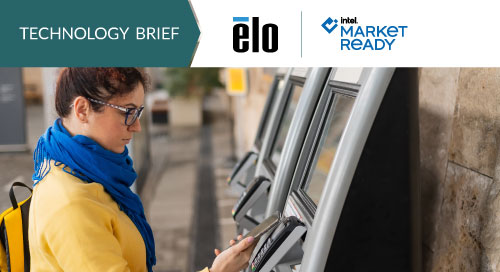The Versatility of Interactive Touchscreens

The interactive touchscreen is a remarkably adaptable technology. It’s been used in every conceivable setting: from movie theaters and restaurants to healthcare and manufacturing—and even in outer space.
They are ubiquitous for a simple reason: They make life easier. As Rick Smith, Director of Business Development at Elo, a leading touchscreen manufacturer, says, “Interactive touchscreens help people in almost any industry do their job better and spend less time doing it.”
This is critical in an age of digital transformation—when all industries are looking to optimize workflows with technology, and customers value speed and convenience more than ever before. Even though touchscreens are universal, their versatility means that system integrators and integrated software vendors (ISVs) continue to find new uses for them. It also means that they have a bright future, as manufacturers look to integrate them with next-generation technologies like computer vision, voice recognition, and AI.
Digital Transformation on the Shop Floor
In industries with traditional workflows, interactive touchscreens can offer significant opportunities for optimization.
This was the experience of the manufacturer Magnum Piering. The company has been very successful—and its success means taking on larger orders. But in a production facility where space was already limited, that wasn’t easy.
Its operations had a standard machining process, but not optimized for space savings. Design and configuration were handled in one area of the building, and then loaded into a machine on the shop floor. The company wanted to consolidate these functions into a single system so its machinists could do everything in one place.
To accomplish this, it invested in a Hypertherm plasma cutting system, which can be controlled by direct human interaction. But in a harsh manufacturing environment, it comes with safety risks. There are sparks, dust, and metal fragments in the air, and workers wear heavy protective gloves. To solve these problems, Elo deployed open-frame interactive touchscreens as the input device for the Hypertherm machines. Since the platform allows for a high degree of customization, Elo’s engineers were able to optimize the device drivers and input settings so the system could be used with gloves on.
The result is a turnkey solution that dramatically improves Magnum Piering’s machining workflow. With more than 6,000 Elo touchscreens installed throughout its facilities, the company can process orders of up to 500 tons—more than double its previous capacity (Video 1).
Self-Service Shines at the Cinema
Touchscreens also help businesses respond to changes driven by customer preferences. The Kerasotes Showplace Icon Theatre is a prime example. Kerasotes Theatres has been in business since 1909, but like many companies in the hospitality and entertainment sector today, it’s having to adapt to new customer expectations.
“In the ‘new normal,’ customers are demanding convenience above all else,” Smith explains. “There’s a lot of research about what makes customers decide to remain at a site and make a purchase or not. Overwhelmingly, we’re now seeing that customers will leave if the ordering process becomes inconvenient to them.”
At the movies, this means that if customers are running late, or if it’s a busy night, they may decide to skip the candy and popcorn altogether: an unacceptable loss for a business that makes so much of its profits from concessions.
Working with Kerasotes, Elo set up self-service ticketing and concession kiosks based on their all-in-one I-Series interactive touchscreens. Now moviegoers enter the theater and buy tickets and concessions from one of the many available kiosks in the lobby—each unit capable of serving up to 350 customers per day.
The result has been an improvement across the board. Wait times are down and customer satisfaction is up—as are concession sales (Video 2).
Modular Design: The Key to Versatility
It’s pretty clear why businesses want to use touchscreens. But the main reason they can be deployed in so many different settings is their inherently modular design.
To begin with, the touchscreens are diverse. The Elo Touch solution, for example, ranges from handheld models with the form factor of a smartphone all the way up to large-format models with 65-inch displays.
A touchscreen unit with Elo Edge Connect built in can be customized with peripherals: barcode scanners, webcams, NFC and RFID readers, status lights, biometric scanners, and so on. Touchscreen providers also enhance this basic modularity with compute devices to help with controlling complex solutions. Elo, for example, offers EloPOS Pack, a controller for point-of-sale applications thatsupports custom configurations involving up to 15 different peripherals.
Intel® technology makes this modular design possible: “Intel processors give us an extraordinary, flexible, and stable platform for building custom touchscreen solutions,” says Smith. “They provide the high performance required for intensive workloads for advanced applications.”
The changes coming to #interactive touchscreens are really a way of fulfilling their original purpose: to put control back in the customer’s hands. @elotouch via @insightdottech
The Future of Interactive Touchscreens
The evolution of interactive touchscreens that Smith refers to is inevitable. One clear opportunity for transformation lies in self-service applications that are currently handled through touchscreens alone. Computer vision, for instance, could be used to identify products that a customer intends to purchase and speed up self-checkouts.
As Smith sees it, this integration of technologies will be a good thing for both businesses and customers: “People want to make their own choices. Your customers want to choose their own journey. The perfect system will be the one that offers touch, voice recognition, computer vision, and AI in combination—and lets the user drive the interaction.”
In a sense, then, the changes coming to interactive touchscreens are really a way of fulfilling their original purpose: to put control back in the customer’s hands.
This article was edited by Georganne Benesch, Associate Editorial Director for insight.tech.